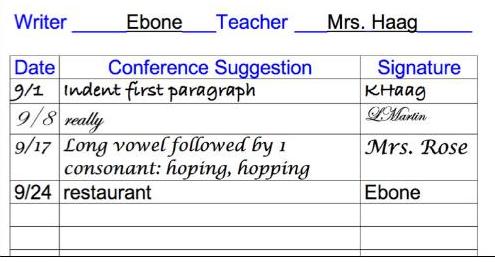|
A key component to self-assessment is daybooks. By having the thinking in one central place, students can refer back to their ideas all year and see progress.
Self-assessment: a key to growth
A key component to self-assessment is daybooks. By recording thinking in one central place, students are able to refer back to their ideas all year. Writers look back over the pages and see progress. The students write reflections in the daybook to be shared with others, reread for inspiration, and reference for tests. The evaluations become as important for growth as the work itself.
For example, often I ask my students to write answers to two questions: “What have you learned? How will you apply the learning to your life?” My kids refer to this evaluation as their “I-learned; I-will statements.” It isn’t enough to be able to regurgitate what they learned back to me. (i.e. “I learned that readers might decide whether or not to read my story based on the first line I wrote.”) I want them to think about how they will use the new information. (i.e. “After I draft, I will look at my lead to see if I can write a better one.”)
Other quick assessments
- Compare and contrast ideas. (i.e. revising vs. editing)
- Draw a picture or symbol of an idea (i.e.: theme).
- Take a Grateful-Learned-Promise walk with a partner. The class walks through the halls 2-by-2. The partners tell one thing they're grateful for, one thing they learned, and one thing they promise to do. If time, you might ask them to record what they said.
- Write a note in double-entry form (i.e. headings – what I noticed/what I wonder).
- Write a question you wish you knew the answer to.
- Write a “good one” – something you heard someone else say they learned.
- Write a Haiku (or other poem) that will help you remember the main idea of today’s lesson.
- Draw a mind map.
- Write a summary of what she accomplished and her plan for the next day.
- Write what you wished you'd shared in class had there been more time.
- I write one test question. Student chooses an answer and explains why.
Writing goals
Students keep a writing-goal page in their daybooks. When I confer with a child, I ask what he is working on and where I can help. Through conferring, I listen and teach. In fluid conference circles, students walk away with a couple suggestions as well. If the other students and I are advising the writer on how to improve, then it's a good idea for everyone to record what was said. I record the goal and the child records the goal in the daybook. We can both refer to the goal later to see if progress is made and if new ones need to be set.
 Conference sheet Conference sheet
Whenever anyone confers with a student in my room, that person records the date, the advice, and her signature. That way, if an assistant, a volunteer, the principal, a parent, or a buddy offer a revision or editing tip, it's recorded. The writer and I add discoveries also. Before papers are turned in to be graded, students check the sheets and fix the writing.
With no conference sheet, all that discussion is lost! The sheets can be made easily on the computer. Write the name of the student at the top. Make a table with 3 columns: date, suggestion, signature.
NEXT: Partner power
|
|